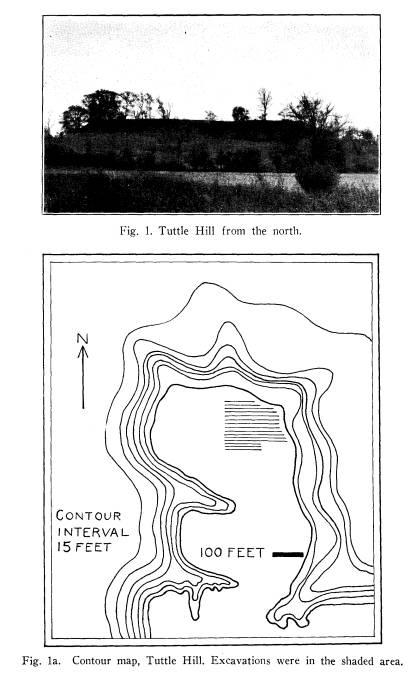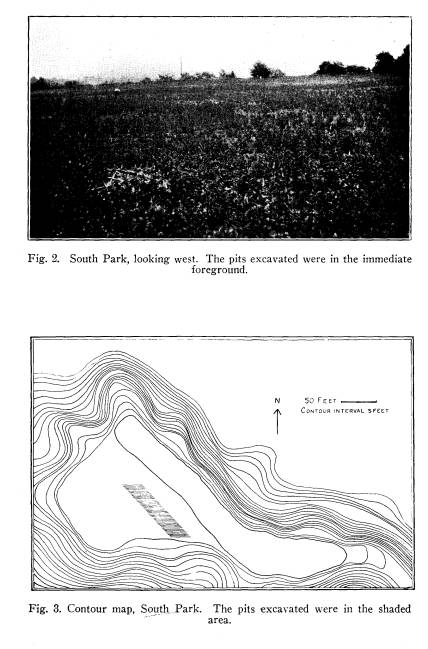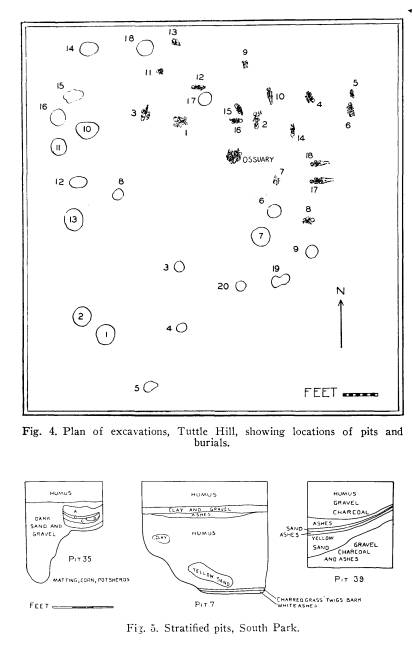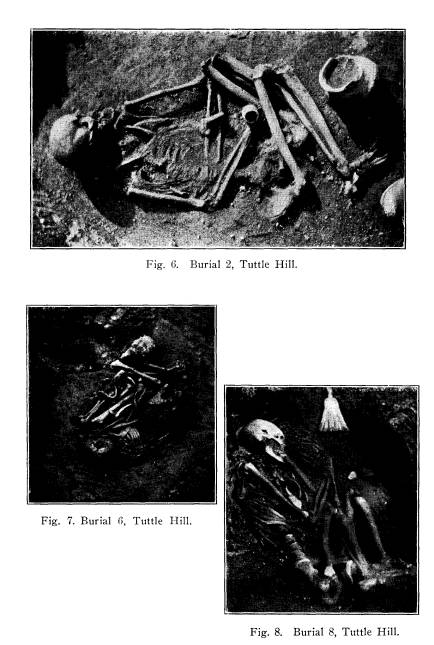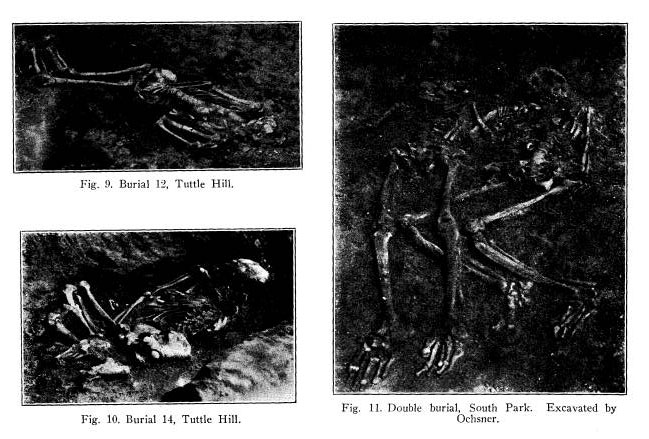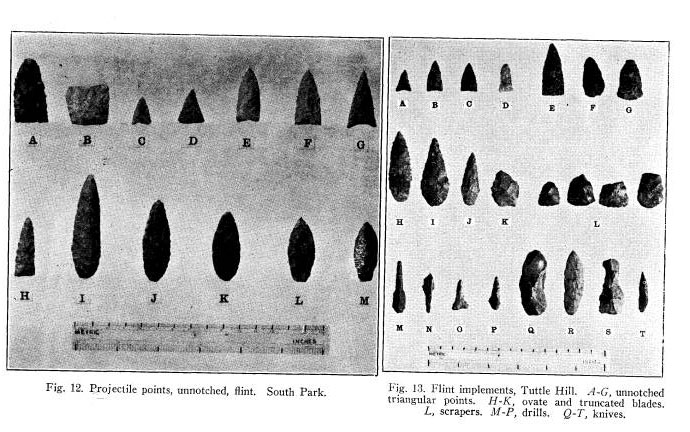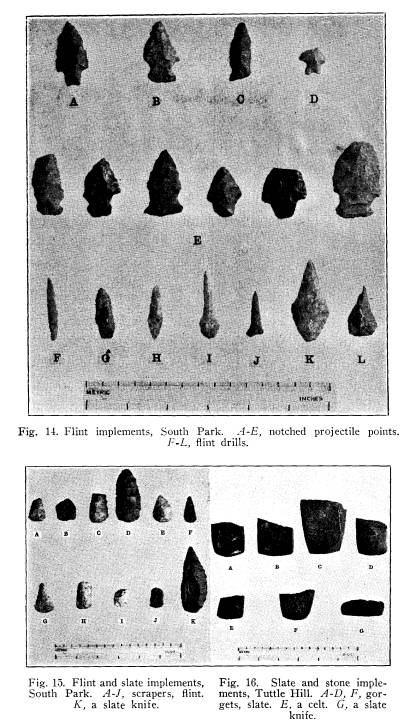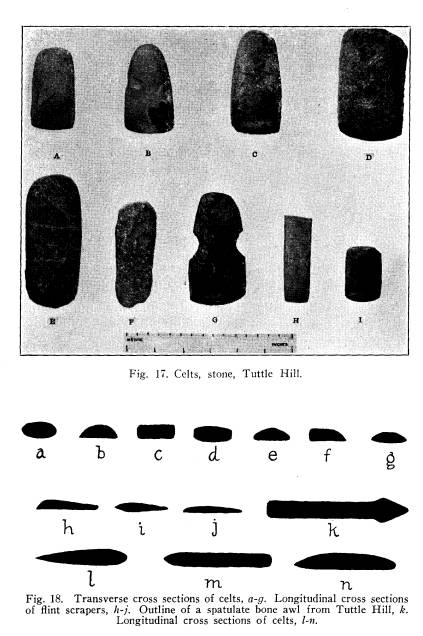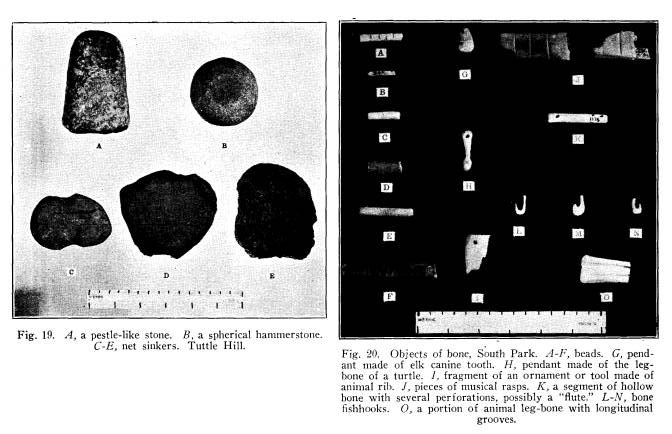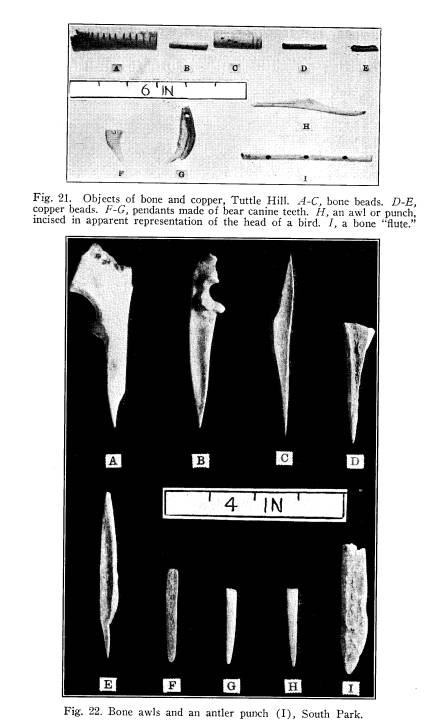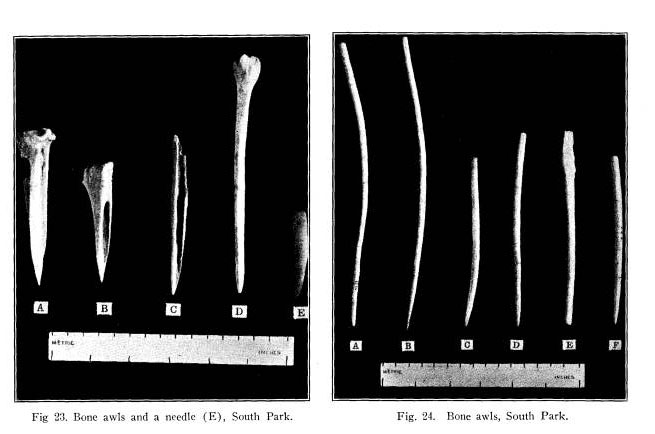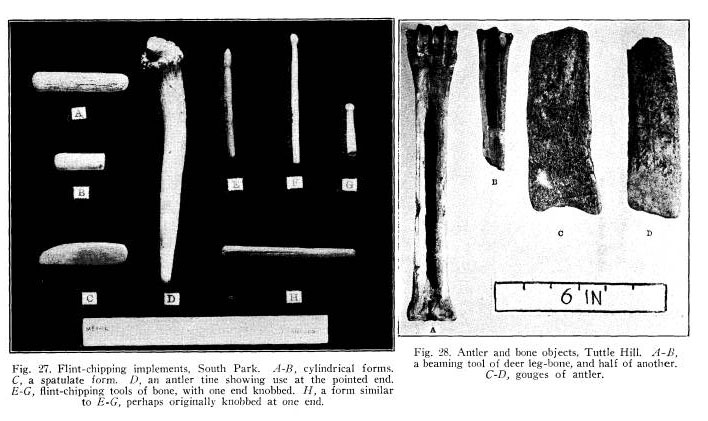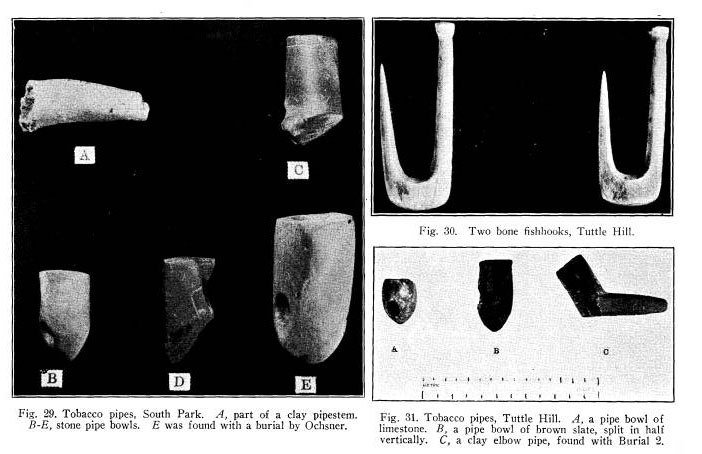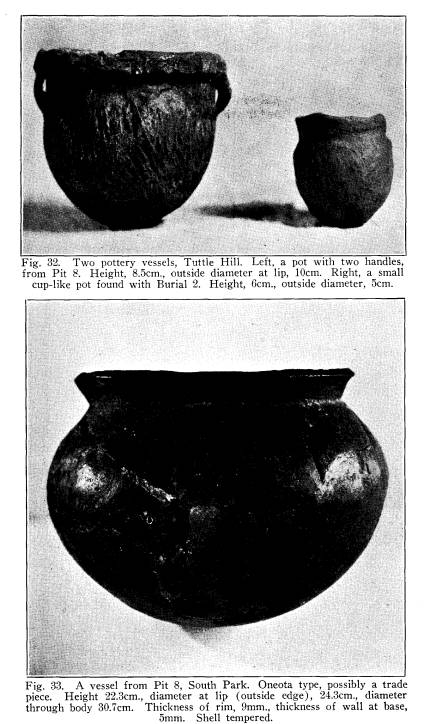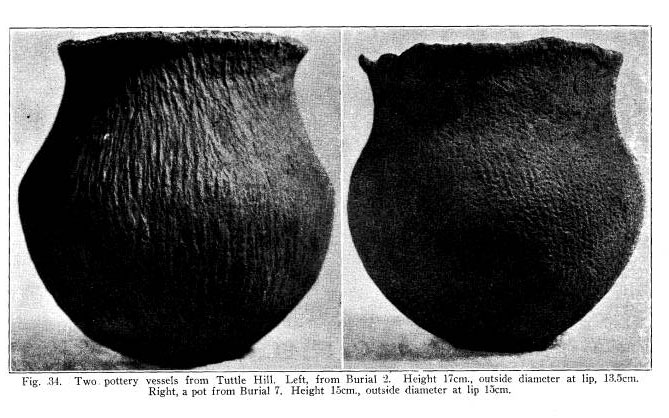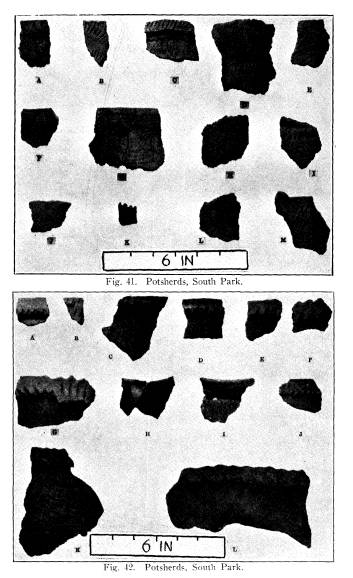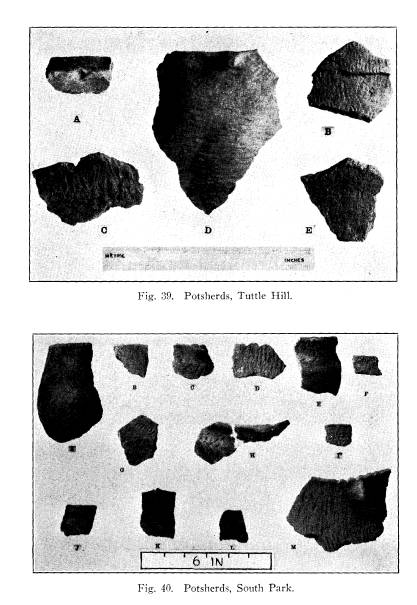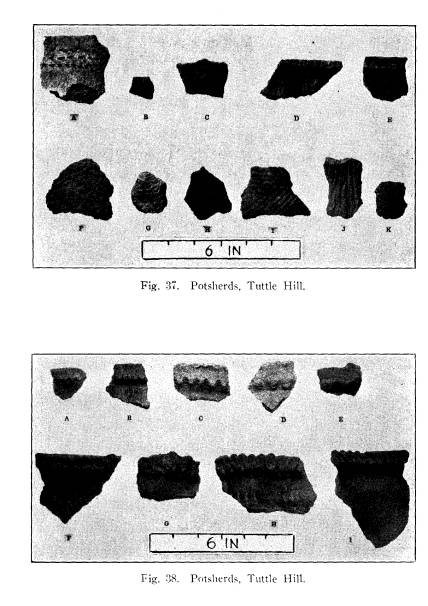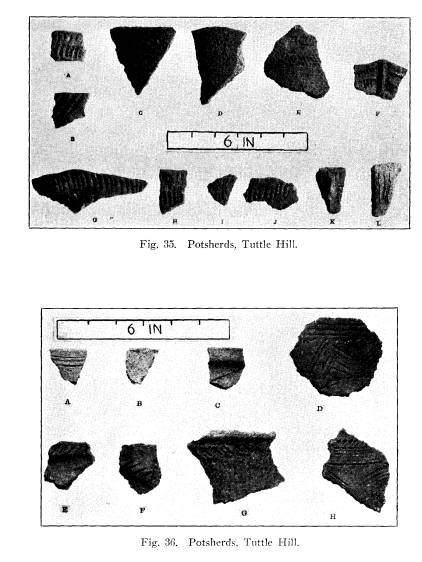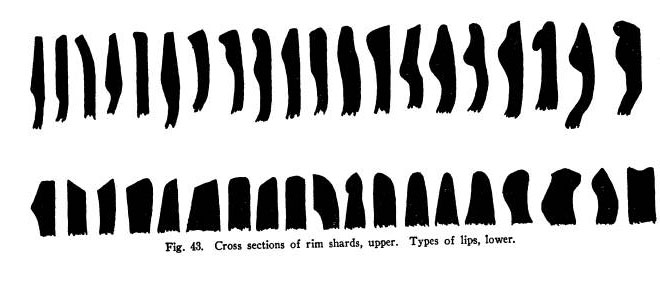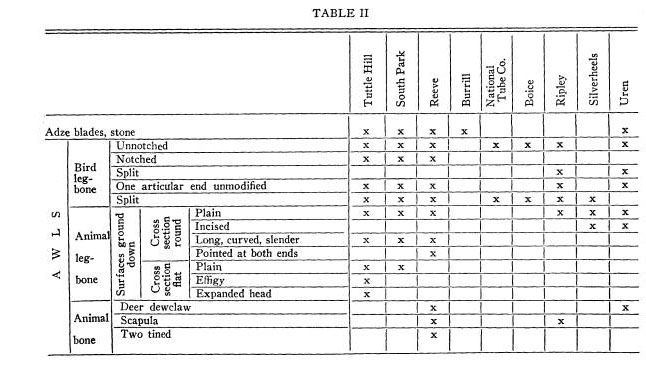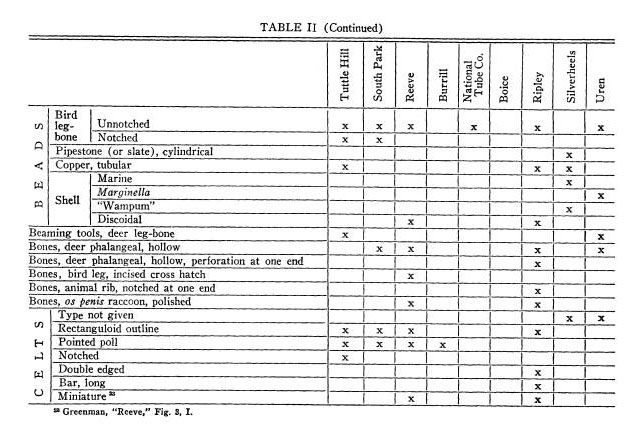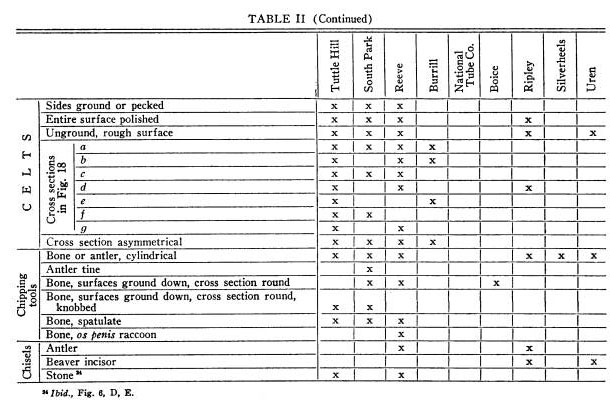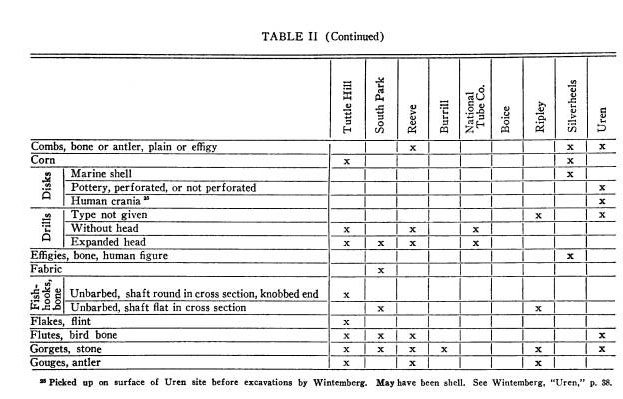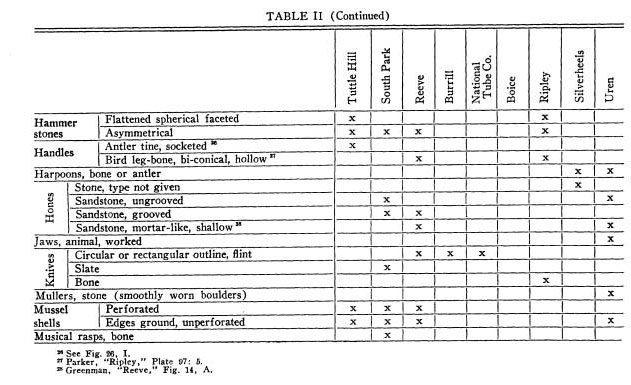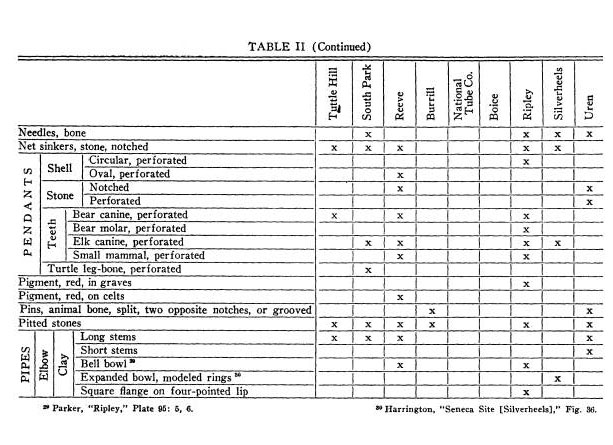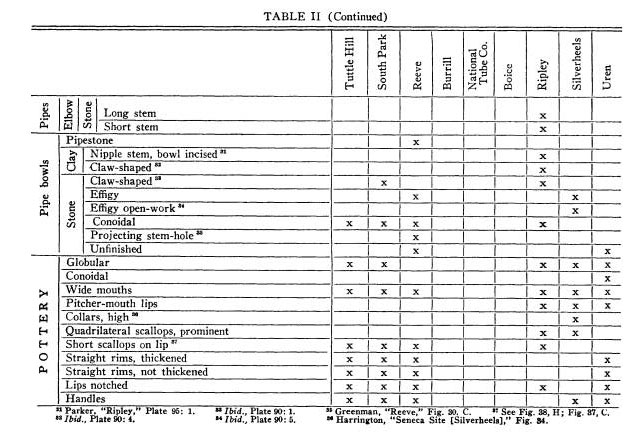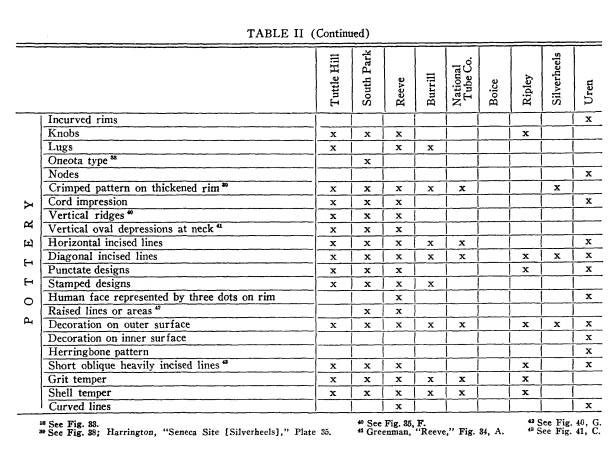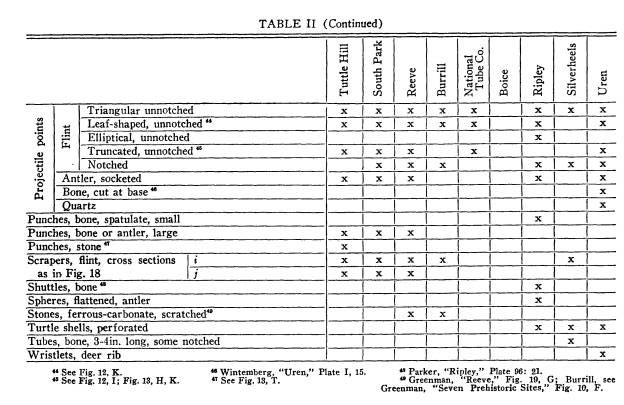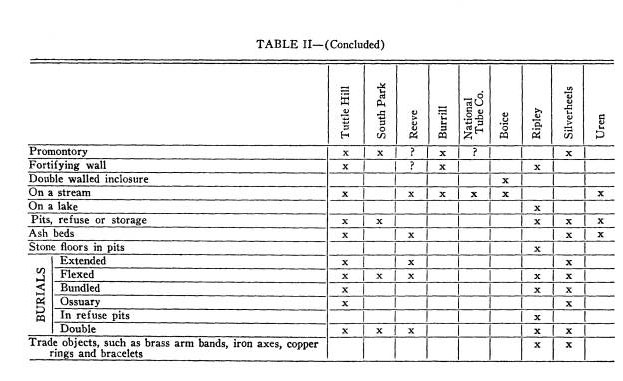Ohio History Journal
- 1
- 2
- 3
- 4
- 5
- 6
- 7
- 8
- 9
- 10
- 11
- 12
- 13
- 14
- 15
- 16
- 17
- 18
- 19
- 20
- 21
- 22
- 23
- 24
- 25
- 26
- 27
- 28
- 29
- 30
- 31
- 32
- 33
- 34
- 35
- 36
- 37
- 38
- 39
- 40
- 41
- 42
- 43
- 44
- 45
- 46
- 47
- 48
- 49
- 50
- 51
- 52
- 53
- 54
- 55
- 56
- 57
- 58
- 59
- 60
- 61
- 62
TWO PREHISTORIC VILLAGES NEAR
CLEVELAND,
OHIO
By EMERSON F. GREENMAN
Foreword
During the field season of 1930 four
sites in northern Ohio
were excavated for the Ohio State
Archaeological and Historical
Society. The two forming the subject of
this paper were on
the Cuyahoga River six and seven miles
south of the Public Square
of the city of Cleveland. Excavations
were under the direction
of the writer and Mr. Robert Goslin,
field assistant. Tuttle Hill
was excavated first, and upon
termination of the work there, the
site at South Park was begun. While in
both cases the privilege
of complete excavation was denied, the
nature of the artifacts
obtained, and other traits observed
during excavation, are suffi-
cient to establish a close relationship
between the two sites.
Reports upon both sites were in
manuscript form within two
years after their excavation, but owing
to lack of funds they
could not be published at that time.
Further delay was occasioned
by the decision to combine the two
reports into a single paper,
and since they were originally separate,
complete reorganization
of both was necessary. Few changes from
the original manu-
scripts have been made in the
descriptions of artifacts, and if the
present paper does not reflect to the
fullest extent the improve-
ments in methods of ceramic analysis
that have been made in the
past two years it is due to the fact
that I have not had an oppor-
tunity to re-examine the collections
during that time.
I wish to thank Mr. Thomas Donkin, of
Cleveland, for
bringing these sites to my attention,
and for his help in obtain-
ing permission for excavation. My thanks
are also extended to
Mr. Eugene Ochsner, of Berea, Ohio, who
provided me with a
(305)
306
OHIO ARCHAEOLOGICAL AND HISTORICAL QUARTERLY
detailed report of the excavation of a
double burial at South
Park, for incorporation in the present
report. I am indebted
to Dr. James B. Griffin of the Museum of
Anthropology of the
University of Michigan for his advice in
determining the rela-
tionship of Tuttle Hill and South Park
to other sites in the Great
Lakes region, and for placing the
facilities of the Ceramic Reposi-
tory at my disposal. For the
identification of mollusks I am
indebted to Mr. Calvin Goodrich of the
Museum of Zoology of the
University of Michigan, and for some of
the animal remains,
to Mr. Gerrit S. Miller of the
Smithsonian Institution; and for
description of fabric remains from South
Park, to Mr. Horace
Miner. I wish also to express my
appreciation to Mr. Richard
Morgan, curator of archaeology of the
Ohio State Archaeological
and Historical Society, for providing me
with descriptions, and
more satisfactory photographs of certain
objects, and for reading
the typescript previous to its
publication; and to Mr. H. C.
Shetrone, director, and Dr. Harlow
Lindley, editor of the Society,
for their patience in awaiting the final
report.
Description of the Sites
The Tuttle Hill and South Park sites are
promontories which
extend out from elevated land bordering
Cuyahoga River, at
the north and east ends of the village
of Independence, Cuyahoga
County, respectively. The top of Tuttle
Hill is level, and 120 feet
above the flood plain of the river,
which approaches to within
750 feet of the base of the north end of
the hill. The promon-
tory itself is about eight acres in
extent, with an irregular outline
and bluffs of varying degrees of
steepness. It was early recog-
nized as the site of a pre-Columbian
Indian village, and first
surveyed, by Charles Whittlesey of
Cleveland, about the year
1850.1 In 1930 the resident, Mr. O. B. Waltz, who gave permis-
sion to excavate, reported the former
existence of a pair of earthen
walls with outer ditches which traversed
the south end of the
promontory, a feature which is confirmed
by Whittlesey's map,
although he says (p. 11) that there was
no ditch in connection with
1 Charles Whittlesey, "Ancient Earth Forts of the Cuyahoga Valley,
Ohio." West-
ern Reserve and Northern Ohio
Historical Society, Tracts (Cleveland), No. 5 (1871).
TWO PREHISTORIC VILLAGES 307
the inner wall. There was also a small
circular inclosure along the
east bluff to the south of the
transverse walls. Neither the walls
nor the inclosure are now in evidence.
The South Park site is on the top of a
promontory with a
precipitous rise of ninety-five feet
within a horizontal distance of
seventy-five feet. It is connected with
high land bordering the
river valley flats by a narrow ridge
about twenty feet wide and
300 feet in length. The river is at a
distance of half a mile to
the east, but a brook, no more than five
feet wide in the summer,
runs at the base of the hill on the east
side. No signs of fortifying
walls or ditches were observed, nor
remembered by residents of
the region. The excavations that were
begun here on April
thirtieth were to have been in the
nature of a preliminary exami-
nation, since the planting season was so
near at hand, and permis-
sion was obtained to excavate only in a strip
twenty-five feet wide,
across the site near the south end. It
was found that this area
was occupied by pits, to the exclusion
of burials, and conse-
quently no skeletal material was
obtained. Burials uncovered a
year later however, by Mr. Ochsner of Independence,
are in-
cluded in the present report.
Artifacts, animal bones and shells were
abundant on the
surface of both sites, and for a
distance of two feet beneath. On
both promontories the top three feet is
a dark loam enriched by
humus and decayed animal matter, the
latter resulting from their
occupation as villages. Underlying this
loam is yellow sand and
gravel of undetermined thickness, and
into which most of the
pits penetrated. Both sites have been
under cultivation for many
years. Two weeks after excavations were
brought to an end
on Tuttle Hill, the topsoil was removed
with a steam shovel for
the enrichment of gardens in
Cleveland. This shovel worked
to a depth of about three feet, and
since most of the pits were
from four to six feet deep, many of
those which were not exca-
vated remain undisturbed in their lower
levels.
Excavation at Tuttle Hill was begun at
the northeast corner
of the site near the edge of the bluff,
where human bones had
often been exposed by the plow. Refuse
pits were first encoun-
308
OHIO ARCHEOLOGICAL AND HISTORICAL QUARTERLY
tered however, in the order in which
they are numbered on the
map in Fig. 4. Eighteen pits and the
same number of burials
were found. There were thirty-nine pits
at South Park. The
majority of the pits were filled with
various types of earth, some-
times uniform throughout a single pit,
and sometimes in layers
or irregular masses of different colors
without any apparent rela-
tion to one another, as if they had been
dumped in. With few
exceptions the pits of both sites appear
to have been used only
for the disposal of refuse. The earth with which they were
filled was soft, while the walls had the
firmness of the surround-
ing subsoil. Bones of animals, birds and
fishes, and mussel
shells and artifacts, were found in
varying amounts from top to
bottom.
Oftentimes there were large areas of light-colored clay
and gravel which contained neither
artifacts nor bones, and showed
no other signs of connection with
domestic activities. Vertical
locations of all artifacts, bones and
shells were taken for most
of the pits, for the purpose of catching
any difference in type
from top to bottom which would indicate
passage of time or occu-
pation of the sites by different
culture-groups in succession, and
in the case of organic remains, to
discern any seasonal variation
in diet that might be represented. No
conditions of any signifi-
cance in either respect were noted. The
decorations on potsherds,
generally most sensitive to changes
attending the passage of time
and to differences in culture, were the
same at the lower levels as
at the top.
Three pits at Tuttle Hill, and ten at
South Park, contained
strata of various types, some bearing
artifacts and animal remains,
and showing signs of steady fires. Sterile strata a foot or more
thick often lay at the bottoms of pits,
being differentiated from
the adjoining natural soil by looseness
of texture. The average
pit was filled with dark clay loam, or
clay and gravel at South
Park, uniformly mixed with ashes and
charcoal in amounts vary-
ing little from one pit to another, and
containing artifacts and
animal remains. Pit 26 at South Park had
at the base the remains
of a fire which had burnt the bottom and
sides red. A small pile
of heat-fractured stones lay directly
over large charred pieces of
wood.
TWO PREHISTORIC VILLAGES 309
The great majority of pits at both sites
were nearly round,
with perpendicular sides and flat
bottoms. The largest of the
pits with circular outline was Pit 7 at
Tuttle Hill, with a diameter
of seventy-two inches and a depth of
sixty-eight inches; the
greatest diameter observed at South Park
was that of both Pits 7
and 33, seventy inches. Both were
sixty-three inches deep. The
least diameter at Tuttle Hill was that
of Pit 4, which was thirty-
eight inches in diameter and forty-two
inches deep. A smaller
pit at South Park, No. 31, was
thirty-two inches in diameter and
forty inches deep. A direct ratio between diameter and depth
was noticeable at both sites.
Eight pits were joined together at South
Park, and two at
Tuttle Hill; at the latter site Pit 19
was a refuse pit at the west
end; the opposite side may have been an
empty grave pit, since
it contained nothing but a copper bead
(Fig. 21, D), while arti-
facts, and refuse material were found at
various levels at the
other end. The sides of but one pit at
each site sloped inward
toward the bottom; Pit 16 at Tuttle Hill
was fifty-one inches in
diameter at the top, and twenty-seven
inches at bottom; at South
Park, Pit 34 had an upper diameter of
sixty and a lower diameter
of thirty-seven inches. Two pits at
South Park were irregular
on one side, descending from top to
bottom in a series of unequal
step-like projections (Pits 7, 35). Pit
27, at South Park, may
have been two conjoined pits, one
thirty-five inches deep and the
other fifty-seven inches deep. But four well-defined strata
extended the entire diameter of the
upper part, and three more
were in the deeper portion, which was
twenty inches in diameter,
with perpendicular sides and rounded
bottom. The distance
across both parts of the pit was
fifty-eight inches.
The organic material in a single pit,
consisting of the bones
of animals, birds and fishes, and mussel
shells, sometimes amounted
in bulk to half a bushel. Three pits contained fragments of
human bone, in Pit 11 at Tuttle Hill a
short fragment of rib, and
in Pits 7 and 32 at South Park a
fragment of skull plate. The pits
at South Park contained much more in the
way of organic remains
and artifacts than those at Tuttle Hill.
The twenty pits at the
latter site contained in all seventy-two
artifacts, 1159 potsherds
310 OHIO ARCHEOLOGICAL
AND HISTORICAL QUARTERLY
and one entire pot, and 806 bones and
fragments of bones of
animals, birds and fishes, and mussel
shells. The first twenty
pits at South Park contained 179
artifacts, 1977 potsherds, and
5356 bones and mussel shells. The
figures for individual pits
at South Park range as follows: From Pit
13, with two artifacts,
fifteen potsherds and no animal remains,
to Pit 4, with ten arti-
facts, 154 potsherds and 918 bones and
mussel shells. The
majority of pits at South Park resembled
the latter in the amount
of material which had been cast into
them. A definite tendency
was observed at Tuttle Hill for all
objects to lie with their long
axes horizontal rather than slanting or
vertical. This suggests
that they were thrown in singly,
unaccompanied by the earth in
which they were found, as if, with
respect to the animal remains
at least, those who threw them in
performed the act while eating
in the immediate vicinity. However it is not conceivable that
this would hold for unbroken artifacts
such as projectile points.
These may have been imbedded in
unconsumed pieces of meat,
thus escaping notice. No observations on the positions of bone
fragments and artifacts were taken at
South Park.
In Table I, is a complete list of the
animal remains found in
the pits, in descending order as to
numerical importance.2 There
is a direct relation between the number
of pits containing the
bones of a given animal, and the number
of bones of that animal
in single pits. Thus at Tuttle Hill,
five pits contained sixty-nine
deer bones in amounts varying for each
pit from two to thirty-five.
Five pits contained only seven bear
bones.
In the table mussels appear second in
importance as sources
of food. This means only that mussels
were a common article
of food, not that the contents of the
pits show that consumption
of mussels was nearly equal in bulk to
the amount of deer meat
consumed. The number of mussel shells
per pit, including frag-
ments and specimens that had been
artificially modified, was small.
The average at Tuttle Hill was 4.5 per
pit; at South Park, 10.3
2 Identification of animal remains were made by Mr. Robert Goslin for
those speci-
mens for which there was comparative
material in the Museum of Zoology, University
of Michigan. The remainder were
identified by Mr. Gerrit S. Miller of the United
States National Museum at Washington.
There were of course many bone fragments
that were unidentifiable.
TWO PREHISTORIC VILLAGES 311
per pit. At the latter site the largest number of
shells in a single
pit (No. 4) was fifty. Five pits contained no mussel
shells. The
total number of shells, fragments of shells and worked
specimens
in the pits at South Park was four hundred and
twenty-two.
TABLE I
Animal Bones and Vegetable Remains in Pits
Number of Pits
Material Tuttle South
Hill Park
Deer .................... 15 39
Mussel shell ............. 16 36
Fish ................... 11 35
Elk .................... 9 28
Porcupine ............... 8 13
Raccoon
................ 7 19
Bear .................... 7 15
Bird (other than turkey). 8 39
Turkey
................. 6 16
Beaver .................. 6 17
Wildcat ................. 5 5
Skunk
.................. 2 2
Muskrat ................ 2 0
Woodchuck
............. 1 8
Wolf or dog ............ 2 10
Squirrel ................ 1 2
Chipmunk ............... 0 1
Panther ................. 0 2
Fox .................... 0 2
Rabbit .................. 0 1
Turtle .................. 1 6
Corn
.................... 0 4
Butternut ............... 0 1
Of edible vegetable materials, kernels and cobs of corn
were
found in four pits at South Park, and in one at Tuttle
Hill.
The scarcity of the bones of rabbits at both sites
might be
due to some special attitude toward that animal. The
bones of
the panther, fox, rabbit and chipmunk were found only
at South
Park; those of the muskrat only at Tuttle Hill.
The distribution of artifacts and organic remains in
the pits
does not in itself throw light upon the purpose for
which the pits
were dug. Those which were unstratified were apparently
used
entirely for the disposal of refuse, and the few pits
that gave
evidence of steady fires, such as layers of ash of
regular thick-
312 OHIO ARCHAEOLOGICAL AND
HISTORICAL QUARTERLY
ness, may have served the purpose of
retaining the heat for baking,
or for protecting the cooking fires from
the high winds to which
these two promontories were exposed.
At Tuttle Hill two pits, Nos. 2 and 8, contained
layers of
pure white ash, in the former at a depth
of fifteen inches, and
in the latter at a depth of forty-three
inches. This layer in Pit 2
contained mussel shell, fragments of
animal bone all of which
were calcined, and a few lumps of clay
burnt red. The sequence
of strata in these two pits is nearly
the same.
There was an association between layers
of sand and layers
of ash in six pits. Nos. 33, 35 and 39
at South Park, and Nos.
2 and
8 at Tuttle Hill, all had a stratum of yellow sand over the
ash layer. In two of the pits at South
Park, Nos. 33, 39, the
ashes were also underlaid by sand, and
Pit 27 had sand beneath
the ash deposit.
The ash layers of Pit 2 at South Park
and Pit 2 at Tuttle Hill
were both at a depth of forty-three
inches. This deposit at the
former site, thirteen inches thick,
contained charred bark, grass
and wood, and the bones of deer,
woodchuck, dog or wolf, elk,
turkey, bear, porcupine, raccoon, fish,
and mussel shells. Two
pits, Nos. 7 and 26 at South Park, had
ash layers at the bottom,
and the bottom and sides of Pit 26 were
burnt red. Pit I at
Tuttle Hill had a layer of charcoal one
inch thick at the bottom.
Pit 34 at South Park, the sides of which
slanted in toward the
bottom, had one deposit of ashes three
inches thick at a depth
of three feet, without other strata. In
Pits 32 and 41, there were
two ash layers separated by gravel and
sand, without other strata.
One ash layer was at the bottom of Pit
41.
In addition to the pits at Tuttle Hill,
there were shallow,
irregular areas of various sizes beneath
the topsoil where signs of
domestic activities were abundant. These
may have been lodge
sites, although their outlines were
irregular, and no post-molds
were observed. The largest, located
eight feet directly south of
the ossuary, is referred to as an ash
layer. It was roughly cir-
cular, with a diameter of ten feet. At
the top was a six-inch
layer of ashes and charcoal, beginning
fourteen inches beneath
the surface of the ground. Directly under this, and laterally
TWO PREHISTORIC VILLAGES 313
coterminus, was a stratum of black soil
one foot thick, corre-
sponding in texture to the topsoil, and
containing artifacts and
animal bones. The objects found in this ash layer were not
different in character from those of the
pits, with the exception
of the shards bearing stamped designs
shown in Fig. 35, C-E, H-L.
The animals represented are deer,
raccoon, dog, beaver; there
were also the bones of fish, birds, and
a few mussel shells.
Burials
At both sites the areas occupied by the
cemeteries were at
the edges of the bluffs, on high ground
at South Park, and on
ground from one to two feet lower than
the area occupied by
pits, at Tuttle Hill. This area was
characterized by light clean
sand, in contrast to the humus and
underlying clay and gravel of
the greater portion of Tuttle Hill. Only one pit, No. 17, lay
beyond the western edge of the cemetery.
Fourteen skeletons were flexed, three
were extended, one
was a bundle burial, and the remains of
seven or more adults,
consisting mostly of disarticulated
bones and skulls, were found
in an ossuary. Two skeletons in a
fragmentary condition pro-
vided no hint of the original position.
Leaving out these and
the ossuary, twelve skeletons were those
of adults, and five were
infants. Of the adults only one was
extended, one was a bundle
burial and eleven were flexed. Three of
the infants were flexed,
and two were extended. Both of the
latter and one of the former
were buried with adults, these three,
and one adult flexion with
a bundle burial, being double burials.
There was no consistent
orientation. Intentionally placed objects were found with four
burials.
In addition to the foregoing there were
two historic burials,
Nos. 17 and 18 on the map in Fig. 4.
Both skeletons lay on the
back in the extended position, heads to
the west. The remains
of coffins, with iron hinges and nails,
were found around each
skeleton. Burial 17 was that of an aged
male whose arms were
extended at the sides. Burial 18, that of a young male, lay
seven feet to the north. The left arm
was flexed with the hand
lying over the clavicle, and the right
arm less closely flexed with
314
OHIO ARCHAEOLOGICAL AND HISTORICAL QUARTERLY
the hand resting upon the thoracic
vertebrae. Both burials were
in clay at a depth of four feet. The
abdominal region of Burial
17 was a cavity into which the clay had
not yet penetrated; the
clay had worked down to a greater extent
into the abdomen of
Burial 18, but the cavity was not
completely filled. As soon
as it became evident that these were the
burials of white men,
Mr. Waltz and other residents of the
region recalled a story to
the effect that two "pioneers"
had been buried on Tuttle Hill
sometime between 1820 and 1850. Burial 18 was
removed.
None of the prehistoric graves was
prepared in any other
way than by simple excavation. The
topsoil where they were
found was sandy, a circumstance possibly
explaining the selection
of the spot as a cemetery. The surface
of this cemetery was
about a foot lower than that of the
greater part of the promon-
tory, and in view of the proximity of
the edge of the bluff it is
possible that a considerable quantity of
sand has been washed
off by rains since the site was
occupied.
The skeletal material was in good
condition, well preserved
except for five skulls that were
crushed, evidently by the weight
of the earth over them. Six skeletons were in various degrees
of incompleteness (Burials 7, 9, 11, 13,
15, 16), one of which, only
twelve inches deep, had probably been
struck by a plow. Burial
15, twenty-six inches deep, had been
disturbed in some other
manner, but enough of the bones were in
place to indicate that
it had originally been a flexion.
The depths of the burials, measured from
the surface to the
upper side of entire crania, and to the
uppermost fragment when
they were crushed, ranged from twelve to
forty-eight inches. The
average depth was twenty-four and
three-tenths inches.
Burial 1. Two skeletons, adult and
infant. The adult was
flexed, with head to the west, facing
south. The infant was in
a position indicating that it was held
in the arms of the adult,
probably the mother, at the time of
burial. The skull adjoined
that of the adult, and the legs, arms
and ribs lay about the face
and shoulders of the adult. The skull of
the infant was crushed,
with the mandible lying upside down. The
adult skull was twenty-
nine inches below the surface. There
were no artifacts.
TWO PREHISTORIC VILLAGES 315
Burial 2. The skeleton of an adult, flexed,
head to the south,
facing west, at a depth of twenty-three
inches (Fig. 6). At the
north end, three inches from the
mid-portion of the tibiae, was a
vessel lying in upright position (Fig.
34, left), part of the rim
of which was missing. Another clay
vessel, much smaller (Fig.
32, right), lay slightly inclined from
the vertical, on the bones
of the lower right arm, and a clay pipe
of the elbow type (Fig.
31, C), with the bowl crushed, lay over
the bones of the left arm.
Burial 3. Two skeletons, adult (probably
female) and infant.
The adult, flexed, lay on the right
side, with head to the southeast
and face to the east. The infant was
extended, and in a position
indicating that it was held in the arms
of the adult at the time of
burial. The depth of the grave was four
feet.
Burial 4. Two skeletons, adult and
infant, at a depth of
twenty-three inches. The adult skeleton,
flexed, lay with the
head to the southeast, and since the
middle of the shaft of the
humerus lay between the upper and lower
jaws the burial had
probably been disturbed, perhaps by the
plow. The infant was
extended, and a clam shell lay four
inches to the southwest of
the bones of the left arm.
Burial 5. The skeleton of an infant,
flexed, head to the
north, skull crushed. The leg-bones had
been disturbed. This
burial lay at a depth of twenty-four
inches.
Burial 6. One flexed skeleton with
skull, and another skull
at the feet (Fig. 7). The skull at the
south end was part of the
only complete skeleton found here. It
was that of an adult,
flexed, lying on the left side facing
west. The other skull, accom-
panied by three leg-bones and bones of
the feet, was a re-burial
of the bundle type. The depth was twenty
inches.
Burial 7. The incomplete skeleton of a
young adult. Only
the right femur, a piece of the pelvis,
the left humerus and a few
ribs were present, lying in position
with regard to one another, at
a depth of thirty-five inches. The head
had been to the south,
and apparently the flexion was not
extreme. A clay pot lay six
inches south of the proximal end of the
femur (Fig. 34, right).
316
OHIO ARCHAEOLOGICAL AND HISTORICAL
QUARTERLY
Burial 8. An adult skeleton, probably
male, lying on the left
side, head to the east, with the arms
doubled upward so that the
hands were in front of the face (Fig.
8). The skull faced south,
and lay at a depth of thirty inches.
Burial 9. The fragments of an adult
skeleton. Only a few
pieces of the skull, and one right
femur, were found at a depth of
eighteen inches. Beneath the fragments
of the skull was a small
celt (Fig. 17, B), and beneath the celt
were forty small flint
flakes.
Burial 10. The skeleton of an adult, extended, head to the
north, arms parallel to the spinal
column, hands beside hips.
Probably a male from twenty to thirty
years of age. The bones
of the left hand were palm down, with
fingers extended. Those
of the right hand were on the side with
the thumb upward, and
the fingers curved in toward the long
bones. The skeleton lay
on the back, facing up, at a depth of
twenty-one inches.
Burial 11. The skeleton of a child of
about eight years,
flexed, head to the west, facing south,
at a depth of nineteen
inches. The skull was crushed, and half
of the lower jaw was
missing. Both arms and legs were flexed,
and the bones of the
feet were missing. The total length of
the skeleton, in a straight
line, was twenty-seven inches.
Burial 12. A male adult skeleton, head to
the west, lying
on the back, with legs slightly flexed
(Fig. 9). The bones of the
right hand lay across the sacrum, with
the fingers on the left half
of the pelvis. The left arm was so
flexed that the tips of the
fingers touched the left collar bone.
The skull was crushed. Depth,
twenty-three inches.
Burial 13. One crushed skull lying separated
by three feet
from two femora, a tibia and a fibula,
and the bones of both feet.
The burial had been disturbed by the
plow. Depth, twelve inches.
Burial 14. The skeleton of a male,
flexed, head to the south,
skull facing east, legs tightly flexed.
The left arm was at full
length, with the bones of the hand at
the middle of the pelvis
and beneath those of the left foot. The right arm was flexed
upward with the hand-bones in front of
and beneath the face.
The skull was crushed. Depth, twelve
inches (Fig. 10).
TWO PREHISTORIC VILLAGES 317
Burial 15. Parts of the skeleton of an
adult, with head to
the north, flexed, facing northeast, at
a depth of twenty-six inches.
This burial had been disturbed sometime
previous to excavation.
Burial 16. The skeleton of an adult,
flexed, head to the
east, with the bones of both hands in
front of the face. The
skull faced north. The left tibia and
all bones of the right leg
were missing. Depth, twenty-six inches.
The cemetery at South Park was along the
bluff on the
northeast side of the promontory, at a
level five and one-half feet
higher than the area where the pits were
excavated. Since no
excavations were made in this area under
the direction of the
writer nothing can be said of the exact
limits of the cemetery.
Later in the summer a double burial was
uncovered by Mr. Ochs-
ner, of Independence (Fig. 11), and his
description follows:
The skeletal remains were fairly well
preserved, the bones of the male
being in better condition than those of
the female. The skull of the female
was badly crushed. Part of an arrow
point was found among the fragments
of the lower jaw, and a whole one was
found between the second and third
ribs. Beneath the fragments of the skull
was the base of an unnotched point.
At the side of the female pelvis toward
the other skeleton was a bone bead.
This skeleton was fully extended.
The male [at the right in Fig. 11] was
well supplied with objects. Over
the abdomen was a steatite pipe, and a
bone bead lay on the pelvis. Three
arrow heads were found in the thoracic
and lumbar regions. At the top of
the right shoulder were a number of bone
or antler chipping tools, a beaver
tooth, a sandstone hone, seven arrow
heads, one broken and one entire drill,
and pieces of worked and unworked flint.
Associated with the burials was
an anvil stone. The soil which covered
the lower parts of the skeletons was
mixed with ashes, and contained
occasional bits of pottery and other refuse
material. None of the bones was burnt.
The depth of both skeletons was
seventeen inches. Both heads were to the
northeast.
Artifacts
Local materials only were used in the
manufacture of imple-
ments and ornaments at both sites, with
the exception of the
two copper beads from Tuttle Hill. The
great majority of manu-
factured or worked objects were
implements, designed to aid in
the securing of food and the making of
clothing; some such as
flint-chipping tools, were used in
making other tools.
Projectile points of the small,
unnotched, triangular type,
made exclusively of flint, predominated.
They range in length
from 17mm. to 43mm. at Tuttle Hill, and
17mm. to 39mm. at
318
OHIO ARCHAEOLOGICAL AND HISTORICAL QUARTERLY
South Park, with proportionate widths
and thicknesses. In only
a few specimens is the length more than
three times the width.
The sides of the majority are slightly
convex, and the bases of
twelve specimens at Tuttle Hill, and one
at South Park, are
slightly concave, the specimen in Fig. 12, G,
exhibiting this fea-
ture to a more marked degree than any of
the others. The ma-
jority of these points are unbroken.
Only one specimen, from
South Park, is made of translucent
material; the rest are light
to dark gray, brown and white, and made
of chert. Including
fragments and rejects, 116 were found at
South Park, and forty-
four at Tuttle Hill.
Truncated and ovate unnotched forms were
also common to
both sites (Figs. 13, J, K, and 12, I-L).
These are larger than
the triangular forms, and all are thin,
symmetrical and well-made.
They were not numerous. South Park
yielded only five, the
longest of which is 6.3cm. Ten notched
points were found at
South Park, all but one on the surface.
The exception (Fig. 14, A)
came from Pit 24, in the thirty-two- to
thirty-eight-inch level.
Fig. 14, D, is of red flint possibly
obtained at Flint Ridge.
Socketed projectile points of antler
were found at both sites.
Two from Tuttle Hill are shown in Fig.
26.
Objects of flint apparently used as
scrapers are shown in
Figs. 13, L, and 15, A-F. They are
classified under three heads on
the basis of longitudinal cross-section:
As in Fig. 18, h, with
one end thickened (beaked type); as in i,
elliptical, with the
thickest portion at one side of center;
as in j, flat, or nearly so,
on one surface, but with the beaked
feature of type h less promi-
nent. The four scrapers found at Tuttle
Hill are of type h
(Fig. 13, L); there are six from South
Park, three of which are
shown in Fig. 15, A-C. Five of the type i
(Fig. 15, F, G), and
ten of the type j (Fig. 15, D, E)
were found at South Park.
The forms in Fig. 13, Q-T, and Fig. 15, K, seem to be best
described as knives, although three of
them have points as well
as edges. Fig. 13, T, is a flake, with
secondary chipping at the
edges on only one side. All of these
forms are made of flint
excepting Fig. 15, K, which is slate,
with secondary chipping. A
|
|
|
(319) |
|
|
|
(320) |
|
|
|
(321) |
|
|
|
(322) |
|
|
|
(325) |
|
|
|
(326) |
|
|
|
(328) |
|
|
|
(333) |
|
|
|
(335) |
|
|
|
(336) |
|
|
|
(337) |
|
|
|
(338) |
340 OHIO ARCHAEOLOGICAL AND HISTORICAL
QUARTERLY
slate knife from Tuttle Hill (Fig. 16, G) has an edge
formed by
grinding.
All types of flint drills are shown in Figs. 13, M-P,
and
14, F-L. The forms K, L, resemble truncated and
ovate points,
but are classed as drills because of their concave
sides.
The larger implements of stone are of five types,
celts, net
sinkers, hammerstones, pitted stones, and rough pieces
of coarse
sandstone bearing grooves evidently made during use in
sharpen-
ing awls of bone.
The majority of celts are made of granitic
materials, and slate; one small specimen (Fig. 16, E)
is fine-
grained sandstone, and another (Fig. 17, H) is
limestone. A
third is made of an eroded schist pebble, and has no
semblance
of an edge (Fig. 17, E). The surfaces of fourteen celts
are
smooth, and those of twelve are more or less coarsely
flaked,
particularly those made of slate. The surface of one
slate celt
has been ground down over the flaking, and that of one
granite
specimen is finely pecked. The sides of four are pecked near
the blunt ends.
In outline the celts approximate more or less closely
the
rectangular, with corners square or round, and the
triangular
(i. e., with pointed poll). The several types of
transverse cross
section are shown in Fig. 18, a-g, wherein the actual
relationship
between breadth and thickness on single specimens does
not
appear. Longitudinal cross sections are of the type l,
m, n, in
Fig. 18. There is more variety in transverse cross
sections, the
complete series of which is shown in Fig. 18, a-g.
Cross sections
duplicating, or closely approaching these outlines,
occur at the
two sites in the following proportions:
Cross section Tuttle South
Hill Park
a .................... 5 5
c ........................ 4 0
c ........................ 1 4
d ........................ 5 0
e ........................ 1 0
f ........................ 2 1
g ......................... 1
1
The notched celt in Fig. 17, G, from Tuttle Hill, made
of
dark gray slate, is unique for both sites.
TWO PREHISTORIC VILLAGES 341
Each site yielded three net sinkers
(Fig. 19, C-E). The
materials are slate and sandstone.
Hammerstones, with and without pits,
some approaching the
cubical in shape, and others spherical
or discoidal, are of slate,
granite, sandstone, quartzite, syenite
and limestone. Fig. 19, B, is
a spherical hammerstone of granite,
slightly flattened on two op-
posite sides. Facets on the sides
indicate a considerable amount
of use in grinding. The elongated
specimen A, in the same illus-
tration, resembles a pestle in shape but
the base shows no modifi-
cation through use. One rectangular sandstone specimen from
South Park, 14cm. long and 9cm. wide,
has from two to three
irregular pits on each face.
Abrading stones were found only at South
Park. All are of
coarse-grained sandstone, and range in
bulk from that of a walnut
to twice that size. Two specimens have
large grooves, one on each
side of one, and one on one side of the
other. The surface of
another is covered with narrower grooves
at various angles to
one another.
The only objects of stone not serving
utility are gorgets, of
which two were found at South Park, and
four at Tuttle Hill
(Fig. 16, A-D). No entire specimens were
found. The two at
South Park are slate, and fragments of
originally rectangular
gorgets; one has a portion of a
perforation. None from Tuttle
Hill shows perforation. Fig. 16, A, has
been pecked on both
surfaces near the unbroken end. Two were
surface finds and two
(Fig. 16, A, C) came from Pits 14 and 11,
respectively.
Eleven different types comprise the list
of bone and horn
objects: awls, beads, beaming tools,
flint-chipping implements,
flutes, fishhooks, gouges, projectile
points, punches, hollow deer
phalangeal bones, and "musical
rasps." The most abundant are
awls, beads and flint-chipping
implements. Bone beads are made
of the hollow leg-bones of birds, with
one exception at South
Park (Fig. 20, E). The surface of this
specimen has been
smoothed by grinding, in which process
the diameters at both
ends have been lessened. The material is
animal bone. Only a
few of the bird-bone beads are notched,
and one (Fig. 21, C)
342
OHIO ARCHAEOLOGICAL AND HISTORICAL QUARTERLY
has a diagonal row of drilled holes with
two incised lines at one
end. The surfaces of most of the beads
are highly polished.
They vary in length from 1.3cm. to 7cm.
at Tuttle Hill, and 1.5cm.
to 4.4cm. at South Park.
Two tubular beads of copper were found
at Tuttle Hill, one
in Pit 19 (Fig. 21, D) and the other in
the topsoil (Fig. 21, E).
These beads were made by bending flat
sheets of copper so that
the edges overlap from 1mm. to 2mm. The only other
object
of metal is a small piece of sheet
copper from Pit 11 at Tuttle
Hill.
The leg-bones of birds and animals were
utilized in the
manufacture of awls. Those of bird bone
are either split longi-
tudinally, or entire except where they
are ground to a point.
Most of the smaller awls of animal bone
are split (Fig. 22, E),
while in the longer punch-like forms
only the pointed ends are
modified (Fig. 26, F). A third type of
awl is made of animal
bone worked down to a round cross
section (Fig. 24, A-F).
The long, slender, curved forms in Fig.
24, A, B, from South
Park, were also represented at Tuttle
Hill by the specimen in
Fig. 26, H, although this specimen is
pointed at both ends, and
the points are blunt in comparison to
the others. The two from
South Park are 22cm. in length; that
from Tuttle Hill is 5cm.
shorter. Fig. 25, K, is spatulate, as is
the specimen with an
expanded head in Fig. 18, k, the length
of which is 4cm. The
only awls with incised lines are those
in Fig. 25, A, and Fig.
21, H.
Fig. 25, J, appears to be a small awl or punch in the process
of manufacture. Fig. 23, E, is made of
split bird bone, and has a
perforation at the upper end. The
punch-like form in Fig. 22, I,
is made of antler.
Objects probably used in the working of
flint by pressure-
flaking are shown in Figs. 26, and 27,
A-C. The cylindrical types,
A, B, in both illustrations, all made of antler, were
predominant.
Fig. 26, B, is an unused specimen which
was cut nearly through
at both ends, from a longer piece of
antler, and then broken off.
Spatulate forms worn at one end are
shown in Figs. 26, C, and
27, C. In the latter illustration, the
knobbed forms E-G were not
TWO PREHISTORIC VILLAGES 343
duplicated at Tuttle Hill; nor was the
complete tine, D. The
form I in Fig. 26, is a section
of a tine 17cm. long, with a
hole at the upper end 2.5cm. in depth.
This specimen is ap-
parently the handle for some cutting or
piercing implement.
The cylindrical flint-chipping tools
have the following dimen-
sions: at South Park, 2.5cm. to 6.2cm.
in length, with an aver-
age diameter of 1cm.; at Tuttle Hill,
3.1cm. to 4.9cm. in length,
with the same average diameter.
Fishhooks were found at both sites.
Those at South Park
are crudely made, probably of bird bone,
and not more than 12mm.
in length (Fig. 20, L-N), while the two
from Tuttle Hill (Fig.
30) are 5cm. long, highly polished, with
fine points, and knobs
at the upper ends to facilitate
fastening to the line. Only one
of the three from South Park has a knob
at the upper end.
The so-called gouges of split antler,
and beaming tools made
of deer leg-bones, were found only at
Tuttle Hill (Fig. 28). Both
sites yielded bone objects that were
perforated at one end ap-
parently for suspension as ornaments.
Two bear canine teeth,
one the deciduous end of the tooth of a
young bear, were found
in the topsoil at Tuttle Hill (Fig. 21,
F, G). In G the hole was
started just below the finished one, but
discontinued at a depth
of .5mm. Fig. 20, G, is a canine tooth
of an elk, and H is the
leg-bone of a turtle. I is a flat
piece of animal bone which may
have served an ornamental purpose.
At South Park, two fragments of elk or
deer rib, bearing
transverse grooves, were found in Pit
35. These are of the type
sometimes termed "musical
rasps." The two specimens J, in Fig.
20, are
probably fragments of the same piece. Two bone "flutes"
were found, one at each site. Fig. 21,
I, has five holes, three on
the side illustrated and two on the
opposite side. While no musi-
cal note can be obtained from this
specimen, objects of this type
are thought to have been used as game
calls. Fig. 20, K, has one
hole on the side opposite that shown.
The only representation of a life-form
is the pointed bone
object in Fig. 21, H. The head of a bird
seems to be the object
represented. The incised design is the
same on both sides. Prob-
344
OHIO ARCHAEOLOGICAL AND HISTORICAL
QUARTERLY
ably used as an awl, this specimen was
found in Pit 14 at Tuttle
Hill.
Other bone objects which can be assigned
to no particular
use were found at both sites. These
comprise sections of cut bird
leg-bone, one of which is encircled with
an incised line near one
end; a short piece of antler tine
incised in the same manner and
showing effects of fire; unworked long
sections of bird bone
highly polished, and one polished
section of the rib of a deer
or elk. Three phalangeal deer bones were
found at South Park,
hollowed out, with a single perforation
about 2mm. in diameter
at one end. Fig. 20, O, is a
section of the end of a deer leg-bone
with four deep grooves. It is hollow,
and the surface is highly
polished.
Artifacts of shell were limited to
mussel shells with the
edges worn or cut, or perforated in the
body. These belong
to the following species: Lampsilis
siliquoidea (Barnes), Ligumia
recta latissima (Rafinesque), and Amblema costata (Rafinesque).
The latter is a much heavier shell than
the other two, and it is
this shell which was perforated,
possibly for the fastening of a
handle for use as a digging tool. The perforations are the re-
sult of fracture rather than drilling or
cutting. The other two
species, with the edges cut or worn,
probably served as scrapers
or fish scalers. The two sites yielded both types.
In Pits 34 and 35 at South Park a
considerable amount of
coarse matting was found, in a charred
condition. The weave
from both pits is of the same type, and
identified as follows by
Mr. Horace Miner:
Plain twine weave, clockwise twisted
woof. The warp is single, flat,
7mm. wide on the average, and consists
of strands of grass or reed 1cm.
apart, measured from center to center.
The woof consists of single elements,
twisted or untwisted, from 1.5cm. to
3.5cm. apart.
A section 5.5cm. long, of three-ply
braided rope, charred,
was also found in Pit 34. Each strand is
8mm. wide and 4mm.
thick on the average. The rope formed by
braiding the strands
is oval in cross section, 1.5mm. wide
and 8mm. thick.
Five tobacco pipes were found at South
Park, and three at
Tuttle Hill. Two types are represented,
elbow pipes of clay, and
TWO PREHISTORIC VILLAGES 345
pipe bowls of stone. Fig. 29, A, is the
stem of an elbow pipe
of clay, with shell tempering. The clay
pipe C, in Fig. 31, from
Tuttle Hill, is tempered with grit. This
pipe was found with
Burial 2. Fig. 31, B, is of reddish slate,
and A is light gray
limestone. The stone pipe bowls from
South Park are of slate.
The only decoration on these pipes are
the incised lines on C and
D, in Fig. 29. That on D is evidently part of a figure of some
sort. E lay on the abdomen of the
burial uncovered by Mr.
Ochsner.
Pottery
Both sites were prolific in pottery,
about four thousand frag-
ments of which were found in the pits
and in the topsoil. Four
entire pots were found at Tuttle Hill
(Figs. 32, 34) and one at
South Park (Fig. 33).
Paste. The clay ranges in texture from
medium to coarse,
and in color from black to light gray or
brown, with occasional
areas of red. Tempering materials
consist of pounded shell or
rock, and sand, with a proportion of
grit to shell for decorated
shards of about two to one, the grit
temper predominating. Grit
temper is mainly pounded granite, in
particles from the barely
visible to lumps a millimeter thick and
two or three millimeters
in length. In a few shards the tempering
materials consist of
coarse lumps of white chalky material,
and large unbroken pebbles
with the bulk of a pea were found in two
shards. Grit and shell
tempering are present in the same shard,
but rarely.
Surface finish. Modification of outer
surfaces of pots was
accomplished while the clay was plastic,
by manipulation with
implements of bone or wood, occasionally
by cord impression,
with a resulting roughened
appearance. On undecorated shards
this roughening often extends from the
lip downward, but on most
others it stops at the shoulder, with
the bases sometimes left
smooth.
The roughening of the surface extends across the lip
on three shards from Tuttle Hill. (See Fig. 39, C.) In Fig.
37, F-K, is shown the range in variety
of surface treatment at
Tuttle Hill. The majority of shards with roughened surfaces
have the appearance of I and H.
The latter may be a cord impres-
346
OHIO ARCHAEOLOGICAL AND HISTORICAL
QUARTERLY
sion like that of the entire pot in Fig.
34, right. Variations of
the latter predominate, with the lightly
incised or trailed lines
in groups at angles to one another, or
roughly parallel in a ver-
tical, horizontal or slanting position.
Cord impression is rare,
and the types of surface modification
represented in F. G and K
are unique for both sites. One shard
from South Park was part
of a pot the surface of which had been
brushed lightly by the end
of a reed or a small bundle of grass, in
vertical strokes leaving fine
striations. On another shard from the same site the body
roughening was accomplished in two
processes, slanting upward
in one direction first, then again over
it and slanting in the opposite
direction, forming a roughly
cross-hatched pattern. Body rough-
ening extends to the lip on undecorated
shards, and to the shoulder
on most of those bearing crimping on the
rim.
Outer and inner surfaces usually differ
as to color, prob-
ably because the former was subjected
directly to modification
incidental to handling, and to heating
in a fire. Both surfaces
of many shards, particularly at and near
the lip, are heavily
caked with carbonized grease.
Only one shape is represented in the five
entire vessels, a
deep bowl with wide mouth and round base
(Figs. 32-34).
Shoulders are for the most part, as
indicated by fragments, a
broad curve rather than a definite line
or ridge such as that ex-
hibited by the vessel in Fig. 34, left.
The pot in Fig. 33 is
of a type characteristic of the Oneota
aspect of Iowa and ad-
joining states. It is the only one of
the kind found at either site,
and does not occur elsewhere in Ohio so
far as is known. The
globular body, the height and angle of
the rim, the indentations in
the lip, and a design consisting of
diagonal broadly incised lines
on the shoulder, are the features which
place this vessel, possibly as
a trade piece, in the Oneota.3
The great majority of rim shards at both
sites show a greater
thickness at and just beneath the lip
than at the neck, resulting
3 Actual specimens in the Ceramic
Repository of the Museum of Anthropology,
University of Michigan, and notes on
Oneota material in Iowa, Nebraska and Missouri,
collected by Dr. James B. Griffin
support this identification. See also Charles Reuben
Keyes, "Progress of the
Archaeological Survey of Iowa," Iowa Journal of History and
Politics (Iowa City), XXIII (1925), 339-352; W. C. McKern,
"Wisconsin Pottery,"
American Anthropologist (Menasha, Wisconsin), XXXIII (1931), 383-9.
TWO PREHISTORIC VILLAGES 347
in a moderately "collared"
appearance which is seen in cross sec-
tion in Fig. 43, the last six figures at
the right end of the upper
row. Most of the shards with the rim
thickened in this manner
bear indentations at the lower edge of
the collar, as in Fig.
38, F. This feature is referred to
herein as crimping; it is
predominant at both sites. The
depressions forming the crimped
pattern were made by impression with the
side of a square stick,
leaving a mark v-shaped in cross section
(Fig. 42, A, E, G); by
impression with the side of a round
stick (Fig. 38, C, D, I); or
by modeling, subsequently to impression
with a stick (Fig. 42, L).
Occasionally the notches of the crimped
pattern are ridged (Fig.
38, C).
Lips are either plain, as in Fig. 39, D,
with notches (Fig.
38, C), or with two types of scallop.
The first type is termed
narrow scallop; it resembles a series of notches, but is produced
by modeling. These narrow scallops occur
almost always in
groups of two or more, either at or
between handles, or without
handles as in Fig. 38, H. The second
type, termed wide scallops,
is represented by the shards in Fig. 39,
B and E, and Fig. 35, D.
A few shards have projections at the
lips which apparently served
the purpose of aiding in the suspension
of vessels, either by an
encircling cord or other arrangement.
Fig. 39, A, has a wide
projection described as a lug, with
a depression at its center, and
D has a knob which projects about 12mm. Another type of
projection is the vertical ridge in Fig.
35, F. Lip cross sections
are shown in Fig. 43, lower row.
Decoration. Embellishment of vessels was
confined exclu-
sively to that portion above the
shoulder, with the exception of
the entire specimen in Fig. 33. Two
techniques are represented,
incision and impression, and one or both
are found on the same
pot. Incised designs are made up of
groups of straight lines,
horizontal or diagonal. Impressed
designs are punctate, con-
sisting of depressions, linear or in
simple geometrical shapes like
the circle, square and triangle, and
patterns made by impression
with a notched implement used in a
rocking motion, or stamped.
Examples of the latter are shown in Fig.
35.
348 OHIO ARCHAEOLOGICAL AND HISTORICAL QUARTERLY
Lip
notches were made in the same manner as the notches
forming
the crimped pattern, by impression with round or
square
sticks, or by modeling. Occasionally these notches are also
ridged
(See Appendix, South Park, Division 2.2).
Some
shards at both sites have short oval vertical or slanting
indentations
at the neck.4 Most of these appear to have been
made
by the end of a finger, as they are all about that width.
Inner
surfaces of such shards bulge slightly at the points cor-
responding
to these depressions.
The
numerical occurrence of the main types of design at the
two
sites is expressed in the following percentages:
Design South Tuttle
Park Hill
Without
incised lines .... 16% 24%
With
incised lines ........ 6 3
Crimped
pattern ......... 78 64
Punctate
rows ........... 3 3
Stamped ................. 1 3
In
the Appendix, pages 351 to 356, is a classification of pot-
tery
embracing all decorated shards and all rim shards found at
both
sites. The five entire pots are also
included. Numerical
relationships
for decorative features in combination with details
of
form, and the two types of tempering material, are given. The
various
divisions and subdivisions are numbered in the same
sequence
as in the pottery classification in the report on the Reeve
site,5
in order to aid comparison of the pottery from these three
related
sites.
Conclusion
Tuttle
Hill and South Park are assigned to the Upper Mis-
sissippi
phase of the Mississippi pattern6 on the strength of
their
conformity to the list of traits compiled by Thorne
Deuel,
and their close relationship to a number of sites in western
New
York, assigned to the Iroquois aspect of the Upper Missis-
4
See Emerson F. Greenman, "Excavation of the Reeve Village Site," Ohio
State
Archaeological
and Historical Quarterly (Columbus),
XLIV (1935), Fig. 34, A.
5
Ibid., 47-58.
6
For a discussion of the classification here used, see Fay-Cooper Cole and
Thorne
Deuel,
"Rediscovering Illinois," University of Chicago Publications in
Anthropology:
Archaeological
Series (Chicago, 1937), 207-19. For
terminology, see The Indianapolis
Archaeological
Conference . . . Dec. 6, 7 and
8, 1935 (Washington, D. C.), p. 59.
TWO PREHISTORIC VILLAGES 349
sippi by William A. Ritchie.7 The
following traits listed by
Deuel8
occur at one or the other of the two sites
under considera-
tion:
Agriculture.
Art:
Engraving, on bone.
Burials, extended, bundled, flexed, and
in cemeteries.
Pottery:
Cord body-roughening.
Globular shape.
Grit temper.
Handles.
Shell temper.
Textiles.
Work in shell, bone, copper and stone:
Abrading stones.
Adzes, stone.
Awls, deer ulna, turkey
tarso-metatarsus.
Beads, rolled sheet copper.
Beads, shell, discoidal.
Celts, stone.
Fishhooks, bone, unbarbed.
Flutes, bone.
Hammerstones.
Musical rasps, bone.
Needles, bone.
Projectile points, flint; isosceles
triangle, unnotched; leaf-
shaped, unnotched.
The predominance of the extended form of
burial recorded
by Deuel9 as a Mississippi trait does
not hold for the manifesta-
tions of that culture in northern Ohio.
Of nine determinants for the Upper
Mississippi phase tabu-
7 William A. Ritchie, "A
Prehistoric Fortified Village Site at Canandaigua, Ontario
County, New York," Research
Records of the Rochester Museum of Arts and Sciences
(Rochester, N. Y.), No. 3 (1936),
3.
8 Thorne Deuel, "Basic Cultures of
the Mississippi Valley," American Anthro-
pologist, XXXVII (1935), 433-6.
9 Ibid., 436.
350 OHIO ARCHAEOLOGICAL
AND HISTORICAL QUARTERLY
lated by Deuel,10 six occur
either at Tuttle Hill or South Park.
No exhaustive trait list has yet been
compiled for the Upper
Mississippi phase, but that division as
conceived by Ritchie will
include all the traits of the Iroquois
aspect established by him;
this aspect comprises all foci
attributed to peoples of Iroquoian
linguistic stock.11 Table II shows the
relationship between Tuttle
Hill and South Park as one group, and
two of the sites in western
New
York assigned to the Upper Mississippi by Ritchie;12 Rip-
ley,13 and Silverheels.14
This table gives traits in all possible
detail, and the correspondence between
the two groups in certain
types of artifacts is not as great as it
would be if they were
described in more general terms. If, for
example, celts were
listed as "polished or rough
surfaces," both groups would show
that trait, and the percentage of traits
held in common, to the
total number exhibited by both groups,
would be higher.
Table II also lists the traits from four
other sites in northern
Ohio,15 and one in Ontario,
Canada,16 all of which are related to
the sites in western New York. While the
Uren site in Ontario
possesses certain traits, such as
pitcher mouth lips and diagonal
incised lines, in common with the Ripley
site in New York, the
presence of pots with conoidal bases,
and cord impression, allies it
in part with the Woodlands pattern. In
one detail of pottery design
the Uren site shows a marked
relationship to the Reeve site in
northern Ohio,17 namely, the
abundance of wide bands of hori-
zontal incised lines on the necks of
vessels. Other important
traits possessed in common by these two
sites, situated on opposite
sides of Lake Erie, are as follows: Awls
made of the dewclaws
of deer, combs of bone or antler,
bird-bone flutes, shallow mortar-
like sandstone hones, notched stone
pendants, unfinished stone
10 Cole and Deuel, "Rediscovering
Illinois," Appendix, Table 2.
11 Ritchie, "Prehistoric Fortified
Village," 3.
12 Ibid.
13 Arthur C. Parker,
"The Ripley Erie Site," The Archaeological History of New
York, New York State Museum Bulletin (Albany), Nos. 235/236 (1920), 246-306.
14 M. R. Harrington, "A Midcolonial
Seneca Site [Silverheels] in Erie County,"
The Archaeological History of New
York, New York State Museum Bulletin, Nos.
235/236, p. 207-37.
15 Greenman, "Reeve," 2-64; Emerson F. Greenman, "Seven
Prehistoric Sites in
Northern Ohio," Ohio State
Archaeological and Historical Quarterly, XLIV, 220-37.
16 W. J. Wintemberg, "Uren
Prehistoric Village Site, Oxford County, Ontario,"
Canada Department of Mines, National
Museum of Canada, Bulletin, No. 51: Anthro-
pological Series (Ottawa), No. 10 (1928).
17 Greenman,
"Reeve," 2-64.
TWO PREHISTORIC VILLAGES 351
pipe bowls, ash beds, representation of
the human face by three
dots at lips of vessels, and possibly
the pitcher mouth type of
lip on vessels. The latter is common at
the Uren site, and one
shard from the Reeve site, angular in
vertical plane,18 is either a
pitcher mouth or part of a
square-mouthed vessel, although the
distinctive feature does not show in the
illustration, nor is men-
tion of it made in that report.
The six sites in northern Ohio listed in
Table II constitute
the Iroquois aspect of the Upper
Mississippi phase. Since it
cannot be demonstrated that they were
occupied either by the Erie
or Seneca, to which the Ripley and
Silverheels sites are respec-
tively ascribed by Parker19 and
Harrington,20 they may be placed
in a separate focus, the Whittlesey
focus.21 Twelve miles south
of the Reeve site, at Chagrin Falls in
Cuyahoga County, is
another site which probably belongs in
the Whittlesey focus.
Shards from this site, bearing the
crimped pattern, and diagonal
incised lines, are very close in
appearance to those from the
Reeve site.22
In Table II (pages 357-366) the exact
character of certain
traits does not appear in the terms that
have been applied to them.
Footnotes for these traits have been
supplied, referring to the
published reports of the sites.
Appendix: Classification of Pottery
Designs.
Tuttle Hill.
Rim Shards
1. Plain.
1.1 Without handles or knobs.
21, grit.
1 entire pot, Fig. 34, left.
1 entire pot, Fig. 34, right.
1 entire pot, Fig. 32, right.
Four shards have scallops, and one has
short
oval indentations at neck.
11, shell.
18 Greenman "Seven Prehistoric Sites,"
Fig. 32, B.
19 Parker, "Ripley," 271-6.
20 Harrington, "Seneca Site
[Silverheels]," 236-7.
21 From the name
of Charles Whittlesey, who was the first to survey
and publish
the details of many of the sites
of the Iroquois aspect in northern Ohio.
22 This information was contributed
by Dr. James B. Griffin. The material
is in
the United States National Museum at
Washington, catalogue numbers 27741-27760. In
addition to the pottery there are
bird leg-bone beads, cylindrical bone or antler flint-
chipping implements, stone net
sinkers, and celts.
352 OHIO ARCHAEOLOGICAL AND
HISTORICAL QUARTERLY
1.2 With knobs.
8, shell. Fig. 39, D. This pot had at
least two
knobs at lip, projecting about 1cm. One
shard
has a notched lip.
1.3
With handles.
1, grit. Handle flat in cross section.
1.4 With lugs.
1, shell. Fig. 39. An indentation at
middle of
lug.
1.5 With collars.
11, grit. Fig. 39, B, C. One has
scallops on lip.
Another shard originally had a handle
3mm.
wide, with vertical grooves at the top,
and two
scallops.
2.
Notches in lip, without other embellishment.
2.1 Notches in outer edge.
1, grit.
2.2 Notches extending width of lip.
3, grit. Fig. 39, E. On two shards the
notches
are diagonal and have transverse ridges
in them,
and one of these (in the illustration)
has a
pointed scallop. On the remaining shard
the
notches are diagonal, and V-shaped in
cross
section.
3. Horizontal incised lines.
3.1 Without other embellishment.
1, grit. Fig. 36, A.
5. Diagonal and horizontal incised
lines.
5.4 With punctate rows.
1, grit. Fig. 36, D. The incised lines
were
made by an alternately reversed
movement.
6. Diagonal incised lines, parallel.
6.1 Lip unnotched.
3, grit. Fig. 36, B, C, D. On one the
lines lie
between the edge of the lip and the
bottom of the
collar.
6.22 Notches across lip.
1, grit. Fig. 36, F. Notches are at an
angle.
7. Diagonal lines, incised in parallel
groups at angles.
7.1 Lips unnotched.
2, grit. Fig. 36, G. Both shards from
same
pot. The lines were probably punched
rather
than incised.
8. Crimped pattern without incised
lines.
8.1 Crimping in a ridge of clay which
has been added to rim
just below lip.
105, grit. Fig. 38, A-E, F-H, I.
1, entire pot. Fig. 32 left. With
handles.
50, shell. Three shards are from same
pot.
2, shell and grit.
9.2 Diagonal incised lines with crimped
pattern.
9.21 Without horizontal lines.
1, grit. A group of five diagonal
parallel lines
from shoulder to crimping.
TWO PREHISTORIC VILLAGES 353
10. Rim shards with crimped pattern
fallen off.
6, grit.
3, shell.
12. With punctate rows.
12.1
No other embellishment.
3, grit. Fig. 37, A.
12.2 Notches in lip.
2, grit. Fig. 37, B.
12.3
Collared.
5, grit. Fig. 37, C.
13. Stamped.
6, grit. Fig. 35, A. The shard shown
here has
also single punctate marks. Fig. 35, B.
Notches
across lip. Fig. 35, C, D. In C
there is a double
row of round depressions in the lip, and
in D a
single row; D has a wide scallop.
Fig. 35, F. A
raised vertical ridge extends 4cm. down
from
the point of the scallop, with punctate
marks on
its side.
3, shell. Fig. 35, G, H.
Body shards, decorated
1. Parallel lines.
1.1 No other embellishment.
2, grit.
1, shell.
3. Parallel lines in groups at angles.
1, grit. Fig. 35, I.
4. Crimped pattern.
5, grit.
7. Punctate marks.
7.1 No other embellishment.
6, grit.
8. Stamped.
2, shell. Fig. 35, J, K.
1, grit. Fig. 35, E.
9. Horizontal and diagonal lines.
1, grit. Fig. 36, H. Some of the lines
are
made by alternately reversing direction
of stick
used in incising.
10. With handles.
2, grit. Fig. 35, L. Handle only. Three
verti-
cal lines on face, and notches on the
sides. The
other shard has a handle 24mm. wide at
the
middle portion, and 8mm. thick.
South Park.
Rim shards
1. Plain.
1.1 Without handles or knobs.
17, grit. Fig. 40, A, B. One has a
vertical oval
depression at neck.
4, shell.
354
OHIO ARCHAEOLOGICAL AND HISTORICAL
QUARTERLY
1.2 With knobs.
5, grit. Fig. 40, C, M.
1, shell. Knobs are round, oval or
square in this
series, and taper to a rounded point.
1.3 With handles.
1, grit. Handle 26mm. wide.
1.5 With collar.
1, grit. Slight oval depressions between
collar
and lip, 5mm. deep.
1.6 With notches in lip.
14, grit. Fig. 40, C, D.
3, shell.
1.7 With vertical ridge.
1, shell. Ridge at a scallop, slanting
notches
on sides of ridge.
2. Notches in lip, without other
embellishment.
2.2 Notches extending width of lip.
12, grit. Fig. 40, D. The notches of one
shard
have a single longitudinal ridge at the
base.
4, shell.
2.4 Notches in lip, reaching to neither
edge.
1, shell. The notches are double
indentations at
intervals of 3mm. to 4mm.
3. Horizontal incised lines.
3.1 Without other embellishment.
1, shell. Line poorly incised, 1.5mm.
wide.
3.3 Horizontal incised lines, punctate
elements above lines.
2, shell. Punctate elements on one are
made
up of wedge-shaped figures 2mm. deep,
extend-
ing into outer edge of lip.
3.4 Horizontal incised lines, punctate
elements below lines.
1, grit. The incised lines were made by
alter-
nately reversing direction of the
instrument
used.
5. Diagonal and horizontal incised
lines.
5.1 Without notches or punctate marks.
3, grit. Fig. 41, E. One has a scallop
and a
circular knob.
5.3 Short punctate or incised lines,
vertical or slanting, just
below lip.
2, grit. Fig. 42, C.
1, shell.
5.41 Diagonal and horizontal lines, with
punctate rows.
5, grit. Fig. 41, G. A vertical ridge or
post,
beginning 4mm. below lip, has transverse
notches
The incised lines are 1mm. to 3mm. wide.
6. Diagonal incised lines, parallel.
6.1 Lip unnotched.
2, grit.
TWO PREHISTORIC VILLAGES 355
7. Diagonal lines, incised, in parallel
groups at an angle.
7.1 Lip unnotched.
4, grit. Fig. 41, J. There are rows of
punctate
elements below the incised lines on two
shards.
1, shell. Fig. 41, M. Lip scalloped.
Punctate
marks just below the scallop in a group
of four.
7.2 Lip notched.
1, grit. Fig. 41, K.
1 entire pot, shell. Fig. 33. Incised
lines very
shallow, and smoothed over.
8. Crimped pattern, without incised
lines.
8.1 Crimping in a ridge of clay added to
rim just below lip.
239, grit. Lip scalloped, forty-nine
shards. Lips
notched, nineteen shards. Large oval
shallow
depressions at neck, twenty-five shards.
Small
oval depressions between lip and
crimping, four
shards. Handles, eight shards. On three
there
are vertical lines or grooves just above
the han-
dles. Stamped short lines above
crimping, twelve
shards.
Impressions below crimping, three
shards (Fig. 42, B, C). On one shard the
crimped pattern is formed by a series of
knobs,
circular, round-pointed, 12mm. diameter
at base,
7mm. to 8mm. high, lcm. apart.
73, shell. Lip scalloped, nine shards.
Lips
notched, seven shards. Large oval
shallow de-
pressions at neck, two shards. Small
oval de-
pressions between lip and crimping,
three shards.
Handles, four shards. On three there are
verti-
cal lines or grooves just above the
handles.
Stamped short lines above crimping,
three shards.
8.2 Crimping in outer edge of lip.
Thickness of shard at
lip slightly more than below lip.
2, grit. Vertical irregular depressions below
crimping on both shards.
9.22 Crimped pattern with incised
diagonal and hori-
zontal lines.
1, grit. Fig. 42, J. Row of ovoid
punctate marks
above crimping, just below an incised
line 2mm.
from lip edge.
12.1 With punctate rows (no other
embellishment).
1, grit. Fig. 41, D. Two horizontal rows
of
stamped short lines just below lip, and
other
similar rows in curved lines at neck and
below.
12.21
Notches in lip, punctate rows on outer surface.
8, grit. Fig. 40, G, and 41, B. G has an
area
1cm. wide which is raised 1.4cm. above
the gen-
eral surface.
5, shell. Fig. 40, E, H. H has a
large lug
projecting from the lip, 1.5cm. wide.
356
OHIO ARCHAEOLOGICAL AND HISTORICAL
QUARTERLY
13. Stamped.
6, grit. Fig. 40, K, L; Fig. 41, A, C.
Two
shards (Fig. 40, K, L) have vertical
ridges, that
of the latter being at a broad scallop
with a
notch at its apex. Both ridges bear
transverse
notches. One shard, part of the same
vessel as
Fig. 41, A, has a wide scallop. Fig. 41,
C, has
a collar decorated with diagonal stamped
short
lines.
Body shards, decorated
1. Parallel lines (no other
embellishment).
1, grit.
1, shell.
2.1 Parallel lines with punctate rows
(no other embellish-
ment).
1, grit. Round punctate marks 4mm. apart
be-
tween two parallel lines.
3, shell.
3.1
Parallel lines in groups at oblique angles to one another.
4, grit. Fig. 41, H, I, L.
1, shell.
3.2 Parallel lines in groups at right
angle to one another.
1, grit. Diagonal lines, both groups.
This
shard also bears a row of short lines,
stamped or
incised, similar to those in Fig. 41, B,
but
straight, not curved lines.
7.1 Punctate marks (no other embellishment).
6, grit. The marks are irregularly round
and
triangular. One has a knob, and another
has a
handle, flat in cross section.
1, shell.
TWO PREHISTORIC VILLAGES NEAR
CLEVELAND,
OHIO
By EMERSON F. GREENMAN
Foreword
During the field season of 1930 four
sites in northern Ohio
were excavated for the Ohio State
Archaeological and Historical
Society. The two forming the subject of
this paper were on
the Cuyahoga River six and seven miles
south of the Public Square
of the city of Cleveland. Excavations
were under the direction
of the writer and Mr. Robert Goslin,
field assistant. Tuttle Hill
was excavated first, and upon
termination of the work there, the
site at South Park was begun. While in
both cases the privilege
of complete excavation was denied, the
nature of the artifacts
obtained, and other traits observed
during excavation, are suffi-
cient to establish a close relationship
between the two sites.
Reports upon both sites were in
manuscript form within two
years after their excavation, but owing
to lack of funds they
could not be published at that time.
Further delay was occasioned
by the decision to combine the two
reports into a single paper,
and since they were originally separate,
complete reorganization
of both was necessary. Few changes from
the original manu-
scripts have been made in the
descriptions of artifacts, and if the
present paper does not reflect to the
fullest extent the improve-
ments in methods of ceramic analysis
that have been made in the
past two years it is due to the fact
that I have not had an oppor-
tunity to re-examine the collections
during that time.
I wish to thank Mr. Thomas Donkin, of
Cleveland, for
bringing these sites to my attention,
and for his help in obtain-
ing permission for excavation. My thanks
are also extended to
Mr. Eugene Ochsner, of Berea, Ohio, who
provided me with a
(305)
(614) 297-2300
